
Commercial Range Buying Guide
Commercial ranges are the heart of any kitchen, providing the power and versatility needed to cook various menu items efficiently. With a variety of options available, choosing the best commercial range for your business can seem like a daunting task. Key factors to consider when choosing a commercial range include the size and layout of your kitchen, the type of cuisine you serve, and the volume of food you need to prepare. We'll break down the various types of commercial stoves available so you can find the perfect range to meet your cooking demands.
Shop All Commercial Stoves and Ranges
Commercial ranges, also commonly referred to as commercial stoves, are essential equipment in any professional kitchen. These versatile appliances are designed to handle various cooking tasks, making them a crucial component for chefs and foodservice establishments. Commercial ranges allow chefs to boil, steam, simmer, fry, grill, and saute foods, providing the flexibility needed to prepare diverse menus efficiently.
One of the key features of commercial ranges is their ability to offer different cooking options in a single unit. Most commercial stoves come with ovens, allowing chefs to bake, roast, and broil dishes alongside stovetop cooking. Certain models may also include griddle tops, providing a flat cooking surface ideal for preparing pancakes, eggs, and burgers.
Watch our video to learn more about commercial ranges and the configurations out there.
Play
Mute
Closed captions unavailable
Full screen
When selecting a commercial range for your foodservice establishment, it's essential to consider the specific needs of your kitchen to ensure optimal efficiency and productivity. Beyond the classic range styles, various specialty ranges are available, each designed to cater to different cooking requirements. Based on your menu, kitchen size, and daily volume, you may find that your operation will benefit from having more than one range type.
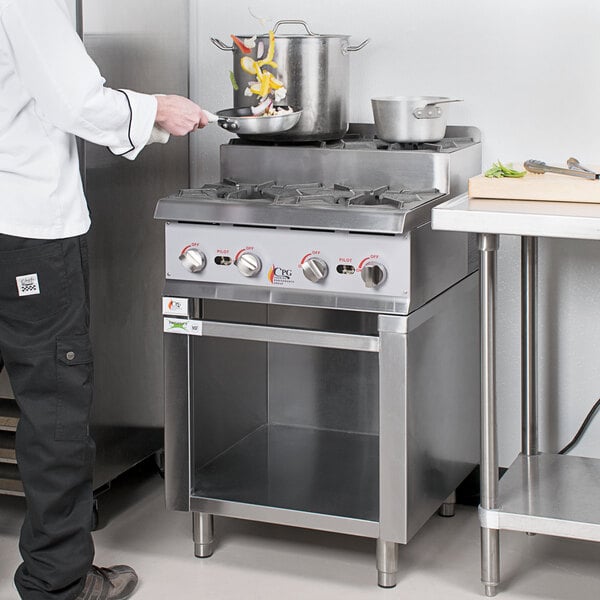
Restaurant Range
Restaurant ranges, also known as medium-duty ranges, are standalone units that offer a cost-effective solution for commercial kitchens. These ranges typically have a gas connection in the back, making them easier to install in various kitchen layouts.
While these ranges have a lighter-duty construction than heavy-duty ranges, they are still designed to withstand the demands of a busy kitchen environment. The burners provide plenty of BTUs for most cooking tasks but will take longer to heat and cook foods than a heavy-duty range. They are also more affordable with upfront and energy costs.
- Power Type: Gas
- Number of Burners: 4 - 6
- Best For: Most commercial kitchens, food stands, and churches
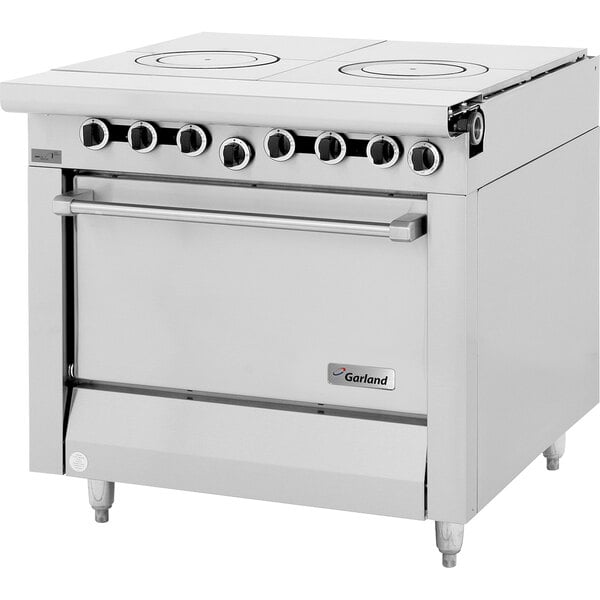
Heavy-Duty Ranges
Heavy-duty ranges are designed for high-volume cooking operations that will be using their range virtually all day to serve a large number of people. These ranges operate with higher burner and oven BTU ratings, offering faster cooking times and increased efficiency. They come with several top configurations and burner options to suit different cooking needs. While heavy-duty ranges may come at a higher price point compared to restaurant ranges, their advanced features and robust construction make them a worthwhile investment for high-volume kitchens.
Heavy-duty ranges are constructed with thicker gauges of metal and more welded components, ensuring long-term durability in demanding kitchen environments. They can be used as standalone units but are typically designed to be banked together "in battery" with other ranges or pieces of equipment, allowing for a customized cooking setup. The gas connection is often located on the side or rear, providing flexibility for various kitchen configurations.
- Power Type: Gas
- Number of Burners: 1 - 12
- Best For: Cafeterias, hospitals, and high-volume restaurants

Countertop Gas Range
Countertop gas ranges are compact and versatile cooking appliances that can be placed on existing countertops or work surfaces. They are perfect for small kitchens, food trucks, or establishments with limited space.
Countertop gas ranges come in standard-duty and heavy-duty models, catering to different levels of cooking intensity. Some gas models feature a step-up design that provides extra cooking space, allowing more dishes to be prepared simultaneously. Many are field-convertible, allowing operators to use natural gas or liquid propane.
- Power Type: Gas
- Number of Burners: 1 - 10
- Best For: Food stands, food trucks, and kiosks
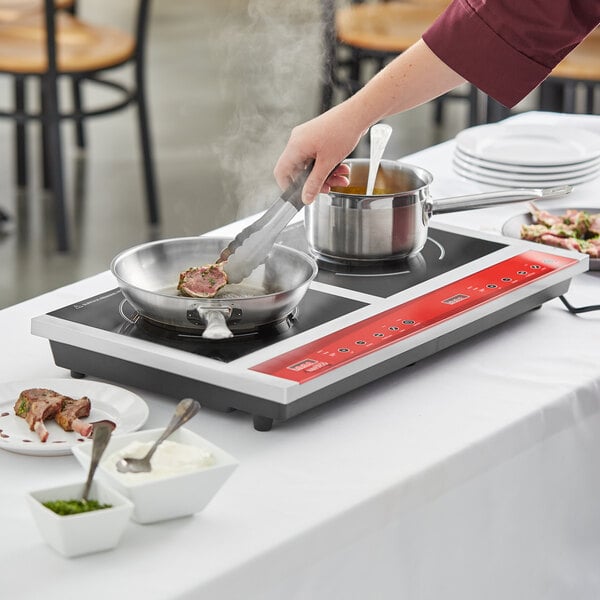
Induction Countertop Range
Induction countertop ranges offer a modern and efficient cooking solution. Some induction models can be used as a drop-in or countertop unit, offering installation flexibility. Portable and lightweight, they are ideal for front-of-the-house operations and display cooking like catered events, breakfast bars, or buffets.
An induction cooker is safer than a gas countertop range since there's no open flame. This means less ambient heat in your kitchen and most importantly no open flame or flammable fuels that could be a potential safety hazard. Many models have built-in safety features like an automatic standby mode once cookware is removed. Induction technology also ensures rapid heating and precise temperature control, allowing chefs to adjust heat levels quickly and accurately and reduce cooking times.
- Power Type: Electric
- Number of Burners: 1 - 4
- Best For: Catering companies, offsite cooking events, and hotels

Wok Range
A wok range is designed for high-heat cooking techniques such as stir-frying, searing, and sauteing. It features high-BTU burners that heat up quickly and a raised ring that supports round-bottomed woks, allowing for fast and efficient cooking.
Restaurants that specialize in Asian cuisine or dishes that require intense heat will benefit from having a wok range in their kitchen. They are a great fit if you have limited kitchen space with a menu heavily dependent on sauteing veggies and meat.
- Power Type: Gas
- Number of Burners: 1 - 4
- Best For: Japanese steakhouse, Asian restaurant, or catering company

Stock Pot Range
As the name suggests, stock pot ranges are specifically designed to heat large stock pots full of soups, stews, stocks, and sauces. Catering companies, cafeterias, and restaurants frequently cooking in bulk will find a stock pot range indispensable.
These ranges typically feature multiple burners or a single large burner with a high BTU output to accommodate the size and weight of stock pots. They are relatively compact units, featuring a low height that reduces the risk of spills and makes it easier to lift large and heavy pots. This helps improve worker comfort and safety in a crowded kitchen.
- Power Type: Gas
- Number of Burners: 1 - 4
- Best For: Catering companies, banquet halls, and cafeterias
Commercial ranges are available in gas and electric models. Each energy source has its own set of benefits and drawbacks. Consider factors such as cooking style, energy costs, safety considerations, and local regulations to determine which energy source is the best fit for your kitchen.

Commercial Gas Range
Commercial gas ranges are the most popular option, favored by many chefs and cooks for their precise control over heat levels. The open flame allows for quick adjustments and even heat distribution, making them ideal for cooking techniques that require rapid temperature changes. Gas ranges require a gas connection and professional installation, which can increase your upfront costs.
- Precise temperature control and fast heat-up times
- More cost-effective option
- Ideal for high-volume kitchens that rely heavily on their range
- Produce a lot of ambient heat in your kitchen

Commercial Electric Range
While they are more expensive to purchase upfront, commercial electric ranges are valued for their energy efficiency, ease of maintenance, and safety. Their biggest drawback is that they do not heat up as quickly as gas models, making them better suited for lower-volume kitchens.
- More energy efficient
- Produce less ambient heat in the kitchen
- Stove surface is easy to clean
- Less precise temperature control
- Do not heat up as quickly
The most common sizes of ranges are 24", 48", and 60" wide, but models are available anywhere from 12" up to 72" - typically in increments of 12" or 18". Restaurant ranges often measure between 24" and 72", while heavy-duty, modular versions will measure between 32" and 36" per section.
When determining the best range width for your kitchen, keep the following things in mind:
Hood Space
Most health/safety codes require the hood to extend at least 6" beyond each piece of equipment you put under it. For example, if you have a 48" wide hood, the widest range you could put underneath it would be a 36" model. It's always best to check with your local regulators to be sure.
Menu and Application
If you're only serving breakfast, do you need open burners, or would you be better off with a griddle or griddle top? For example, if you serve a wider variety of food or different meals, think about how much burner versus griddle space you might need.
- Most range manufacturers offer griddle options in 12" wide increments, so you can tailor the exact configuration of griddle space versus burners to match your cooking needs.
- Some sizes, such as 24" and 48" typically feature "space saver" ovens.
Consider the type of cooking you will be doing in your kitchen when selecting the stovetop configuration for your commercial range. Each option offers unique benefits and caters to different cooking styles and menu items. Choose a stovetop configuration that aligns with your menu requirements and kitchen workflow to maximize the efficiency and performance of your commercial range.
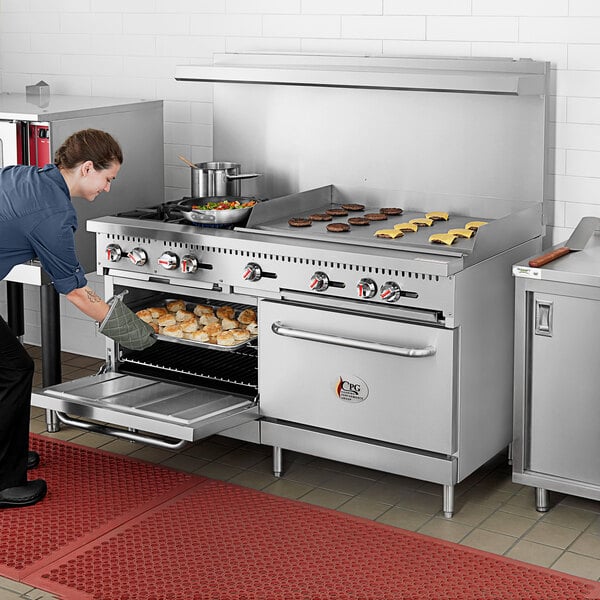
- Open Burner: Open burners are the most common and versatile stovetop configuration. They produce an open flame to provide direct, controlled heat and feature cast iron or stainless steel grates to hold the pot or pan over the burner.
- Griddle Top: Ranges equipped with a griddle top offer a flat cooking surface that is perfect for preparing foods like pancakes, eggs, burgers, and grilled sandwiches. Griddles provide consistent heat distribution and are excellent for achieving even cooking results. They are a popular choice in breakfast and brunch establishments.
- Hot Top: A hot top, or even heat top, consists of a steel plate with a higher heat input than open burners. This configuration is ideal for cooking delicate items that require precise temperature control, such as sauces, custards, and chocolates.
- French Plate: French plates are most commonly used on electric ranges. The round metal plates fit on top of the burner to provide more even heat distribution and promote easier cleaning.
- Plancha: A plancha top is very similar in appearance to a griddle. The center of the plate is hotter than the perimeter, allowing you to sear in the middle and finish/hold food on the edges at a lower temperature.
If you're going with a restaurant or heavy-duty range, the model will likely include more than just the burners. Ranges will frequently come in tandem with ovens, storage cabinets, and other base types that expand their versatility. With so many options available, it'll be up to you to determine what best fits your menu.
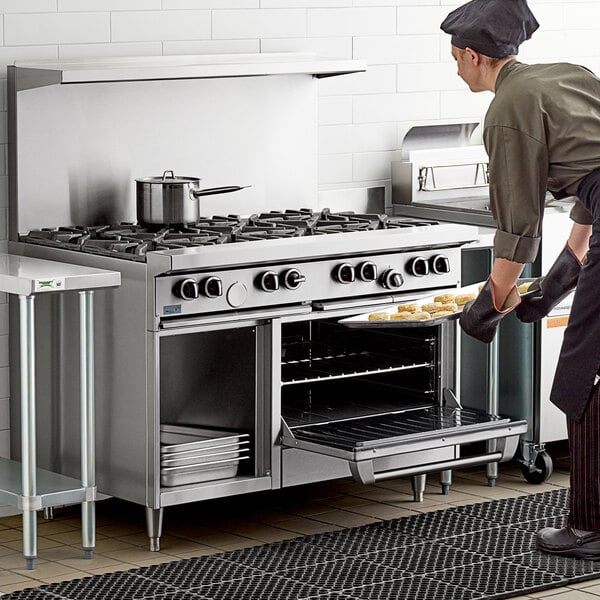
- Standard Oven: The most popular option, standard ovens are at least 26" wide and will hold full size sheet pans in either direction.
- Convection Oven: These ovens utilize interior fans to move the hot air around the cavity and cook food faster and more evenly. These models are more expensive than standard ovens.
- Space-Saver Oven: Ideal for small kitchens, space-saving ovens are approximately 20" wide by 26" deep and can accommodate full size sheet pans lengthwise.
- Storage Base: These are simply an open cavity beneath the range top, in place of an oven, and provide space to hold pots, pans, and other kitchen tools close at hand. Storage bases can range in size from 12" to 36", and they can take up the entirety of the base or share space with an oven or refrigerator.
- Refrigerated Chef Base: A refrigerated chef base keeps cold ingredients nearby and ready to grab at a moment's notice.
By evaluating your kitchen's layout, menu offerings, and cooking volume, you can narrow down your options and select the best commercial range for your business needs. If you're still having trouble deciding which restaurant range to purchase, check out our commercial range reviews to compare the best options out there!
Related Resources

September 2024 WebstaurantStore Coupon Code
Fall is almost here, and to celebrate Webstaurantstore is offering a selection of amazing deals! In September, you'll discover incredible prices on classic fall flavors, glassware, cold cups, and much more! Take a look at our selection of sale items below and don't forget to enter the code COZY24 at checkout to enjoy savings of up to 25%! We're also excited to introduce the new Webstaurant Rewards® Visa Business Card ! Sign up for a new card today and start earning rewards on every WebstaurantStore purchase. Discover the latest discounts on consumable food and beverage items with September's monthly coupon code. From ready-to-bake pastries to classic fall flavoring mixes, you can find great deals on essential consumables for your commercial

ENERGY STAR Appliances and Rebates
If you're looking for ways for your restaurant to go green this year , investing in ENERGY STAR appliances will help your business to save money while reducing your carbon footprint. In this guide, we'll explain what ENERGY STAR is, what it means for appliances, and how you can check if you qualify for any ENERGY STAR rebates. Shop All ENERGY STAR Equipment What Is ENERGY STAR? ENERGY STAR is a voluntary program that provides labels and certifications, backed by the government, that indicate if a product meets a particular energy-efficient standard. ENERGY STAR was established in 1992 by the U.S. Environmental Protection Agency (EPA) as a way to reduce greenhouse gases and other pollutants that are released into the environment by commercia
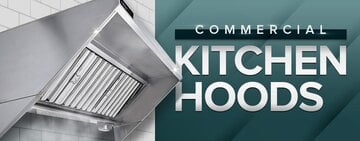
Types of Commercial Kitchen Hoods
Finding the right commercial vent hood for your kitchen is essential for maintaining air quality, keeping the room temperature at a comfortable level, and preventing fire hazards. Which type of hood your restaurant needs will depend on the type of equipment your kitchen has and your local commercial kitchen hood code requirements . This guide will go over the range hood types and restaurant hood systems that are found in a commercial setting as well as hood styles and fire suppression systems to ensure you are outfitting your kitchen with the correct ventilation. Shop All Commercial Exhaust Hoods Use the following links to navigate this guide and learn more about the types of hoods: Types of Hoods Type 1 vs Type 2 Hood Make Up Air for Range
- Topics 1408
- Industrial 55
- Troubleshooting Guides 23
- Restaurant Management 130
- Bar Management 59
- Catering Tips 38
- Bakery Management 43
- Food Trucks & Concessions 50
- Advertising & Marketing 37
- Eco-Friendly Tips 11
- Facility Layout & Design 44
- Coffee Shop Tips 30
- Installation & Maintenance 56
- Janitorial & Pest Control 30
- Safety & Sanitation 95
- Startup Tips 104
- Menu Design 10
- Kitchen & Cooking Tips 85
- Hospitality Management 24
- Pizza & Sandwich Shop Tips 37
- Smallwares 37
- Food Prep 98
- Tabletop Items 18
- Disposables 23
- Calculators & Tools 6
- Consumables 53
- Warewashing & Laundry 18
- Cooking Equipment 98
- Food Storage & Refrigeration 52
- Beverage Equipment 38
- Office Supplies 6


